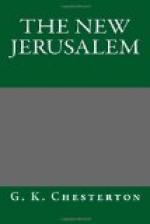As I tried to explain this eccentric sentiment to myself, I was conscious of another which at once completed and contradicted it. It was not only like a memory of Rye, it was mixed with a memory of the Mount St. Michael, which stands among the sands of Normandy on the other side of the narrow seas. The first part of the sensation is that the traveller, as he walks the stony streets between the walls, feels that he is inside a fortress. But it is the paradox of such a place that, while he feels in a sense that he is in a prison, he also feels that he is on a precipice. The sense of being uplifted, and set on a high place, comes to him through the smallest cranny, or most accidental crack in rock or stone; it comes to him especially through those long narrow windows in the walls of the old fortifications; those slits in the stone through which the medieval archers used their bows and the medieval artists used their eyes, with even greater success. Those green glimpses of fields far below or of flats far away, which delight us and yet make us dizzy (by being both near and far) when seen through the windows of Memling, can often be seen from the walls of Jerusalem. Then I remembered that in the same strips of medieval landscape could be seen always, here and there, a steep hill crowned with a city of towers. And I knew I had the mystical and double pleasure of seeing such a hill and standing on it. A city that is set upon a hill cannot be hid; but it is more strange when the hill cannot anywhere be hid, even from the citizen in the city.
Then indeed I knew that what I saw was Jerusalem of the Crusaders; or at least Jerusalem of the Crusades. It was a medieval town, with walls and gates and a citadel, and built upon a hill to be defended by bowmen. The greater part of the actual walls now standing were built by Moslems late in the Middle Ages; but they are almost exactly like the walls that were being built by the Christians at or before that time. The Crusader Edward, afterwards Edward the First, reared such battlements far away among the rainy hills of Wales. I do not know what elements were originally Gothic or what originally Saracenic. The Crusaders and the Saracens constantly copied each other while they combated each other; indeed it is a fact always to be found in such combats. It is one of the arguments against war that are really human, and therefore are never used by humanitarians. The curse of war is that it does lead to more international imitation; while in peace and freedom men can afford to have national variety. But some things in this country were certainly copied from the Christian invaders, and even if they are not Christian they are in many ways strangely European. The wall and gates which now stand, whatever stood before them and whatever comes after them, carry a memory of those men from the West who came here upon that wild adventure, who climbed this rock and clung to it so perilously from the victory of Godfrey to the victory of Saladin; and that is why this momentary Eastern exile reminded me so strangely of the hill of Rye and of home.




